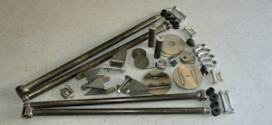Mighty Mouse, Part 1 of 5
About 10 years ago I installed a TBI fuel injected Chevy 350 motor and a Turbo 350 transmission into our FJ40 – both of which were freebies. The engine had been swapped in and out of other vehicles since 1986 and I lovingly named it my ‘mystery motor’, since the innards and mileage were completely unknown. To this day, I still couldn’t tell you if it is a 2 or 4 bolt-main engine, and aside from adding oil to it every few years and conducting the minimally required maintenance, nothing had changed and it served us well. It was on our last trip to Moab, UT for the Easter Jeep Safari, that the years of punishment began to show the effect on the mystery motor. I came off the top turnbuckle on several hard-core trails specifically selected to give a few new products a good beating, and the mystery motor started showing signs of its age. A few more valve rattles, a little more blue smoke from the tailpipe, and a recent, notable lack of power are all this poor motor was capable of producing. It is now time for a new mill to be transplanted and, as the saying goes, “Go big, or go home”.
I made the decision to build my own engine for various reasons that I’ll speak to later in this article. Nonetheless, I enlisted the help of real experts and our good friends at GM Performance Parts, Lunati, Holley and PSC (Performance Steering Components) to pick their brains. After several days of dialogue, questions and technical discussions, they finally convinced me to build, with their help, a 400+ horsepower, 383 cubic inch, fuel injected, Chevy stroker motor. This mighty mouse motor will be adorned with the finest components Holley, Lunati and GM Performance Parts as well as a few other power adding superstars. Here are the highlights of the motor specs, but as I mentioned, we’ll break this article into a 5-part feature to not only tell you what we built, but why and how we built it, step-by-step. Consider this engine-building guide our gift to you, our fellow 4-wheeling friends. Engine Highlights:
Part 1 – Design Plans & Engine PrepSure, we could have ordered a turn-key engine to drop into our ailing FJ40, but we wanted to build our own mill for a variety of reasons. First, we wanted to show you that almost anyone can build their own engine. Second, there’s a level of gratitude and pride that you will have when a buddy or onlooker says “wow, that’s a sweet engine!”, and you reply “thanks, I built it myself”. Third, we could design an engine that fits our specific needs, instead of getting an engine that someone else designed. With that said, we put our call into GM Performance Parts and Holley to have discussions about our needs, which were quite simple; We wanted a small block Chevy engine primarily because of its reliability. The availability and the low cost of parts were primary reasons too. We also wanted a motor that started its power curve at low rpm’s, had gobs of power on tap at high rpm’s for our occasional mud runs and sand dune blasts, and would provide years of trouble-free service – oh yeah, it had to run on pump gas too. Holley and Lunati ultimately put together a very extensive and comprehensive set of engine components that would make up our project mighty mouse motor. Shortly thereafter, the components started showing up at the 4X4REVIEW shop and the project formally began. After the GMPP 383 block showed up, we loaded it up and took it over to our friends at Schmidt’s Automotive in Indianapolis, IN – a famous speed shop that builds engines ranging from direct OE replacements to 1,500 HP nitrous-burning monster mills for top-fuel dragsters. The GMPP crate motor comes ready to assemble, but given that this engine would have the finest components available from Holley and Lunati, and we wanted a perfect build, we decided to have Schmidt’s give it the royal treatment. Schmidt’s performed several key services to our block, such as:
While Schmidt’s was at it on our mill, we had them install new cam bearings and check all clearances on the block, since the connecting rods for a 383 stroker motor swing wider and can come in contact with the cylinder skirts, causing catastrophic failure – never a good thing. The engine is now fully prepped and ready for assembly. Next article… Part 2, The Lower Engine Build
|
 4x4Review Off Road Magazine
4x4Review Off Road Magazine

